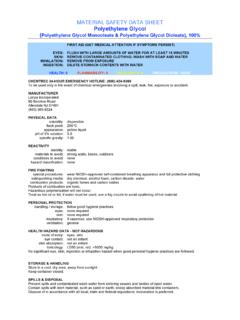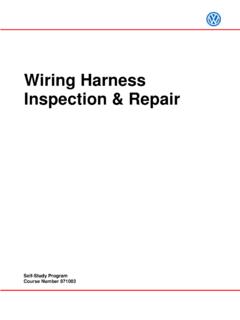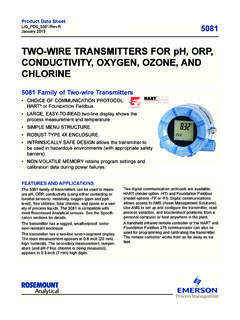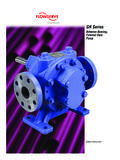Transcription of Closed System Protection Handbook
1 Closed System Protection A HOW-TO Handbook FOR PLANT MANAGERS AND FACILITIES ENGINEERS Water chemistry determines corrosion rate. Corrosion rate determines System longevity. Therefore, water chemistry determines System longevity. !2 Myths Of System Failure It is impossible in airtight systems. It is inevitable because water is corrosive. It is best avoided by using treatment from specialty chemical companies. Such misconceptions can be very expensive. Our mission is to provide objective guidance and leadership in the management and Protection of Closed water loops. This Handbook is designed to help plant managers and facilities engineers make the transition to protective monitoring, which is essential to System efficiency, dependability and longevity. ! Katie Place, HVAC Chemist Closed System Laboratories (608) 213-9328 Table Of Contents Introduction.
2 3 Problems With The Status Quo .. 3 A Typical Scenario Signs Of Trouble About Nitrite Destructive Processes: Causes & Preventives .. 4 Corrosion Scaling Fouling Intelligent Application Of Preventives .. 5 Understanding Safe Zones Implementing Safe Zones Do-It-Yourself Protective Monitoring .. 6 Drawing Samples Analyzing Samples Correcting Chemistry Verifying Protection Professional Protective Monitoring .. 8 Performance Standards Participating Laboratories Appendix .. 9 References Do-It-Yourself Supplies Copyright 2016, Closed System Laboratories Incorporated !3 Introduction In open water systems such as cooling towers and evaporative coolers problems such as corrosion, scaling and fouling are apparent to anyone who takes a moment to peek through the access door.
3 In Closed water systems such as heated, chilled and geothermal loops the interiors of boilers and pipes are permanently hidden from view. Problems such as corrosion, scaling and fouling can proceed unabated, until systems rupture and fail. Most plant managers know that systems are best protected when the chemistry of the circulating water is routinely monitored and corrected to prevent harmful chemical reactions from doing irreversible damage. In others words, they realize that protective monitoring must be applied if systems are to perform for many decades. What many plant managers do not know is how to conduct protective monitoring themselves, or how to find someone who does. Most Closed System water-side management services are really sales schemes. Expensive, brand-name treatments, accompanied by free test kits and log sheets, are marketed by specialty chemical companies.
4 Their commissioned salesmen often have little knowledge of water chemistry and limited technical training. Their focus is product sales, not System science. Protective monitoring is defined and described here, so it may be implemented in-house, or successfully sought and contracted to qualified professionals. Either way, responsible, lifelong System Protection , which holds corrosion at negligible levels and eliminates scaling and fouling, can be accomplished for less than $1 per day of System operation. Problems With The Status Quo A Typical Scenario A new heating System is installed, and responsibility for its care is transferred to the plant manager. He is advised by the industry the manufacturer, the mechanical engineer, the contractor, the boiler inspector, the insurance company to contact a water treatment professional.
5 The problem is there are very few qualified professionals chemical engineers and water chemists in the Closed System Protection business. Chemical sales companies have filled the void with expensive treatment products that are often 85% water. The plant manager may presume these companies will provide the guidance he seeks. Or, if he recognizes they are not an objective source of information, he may choose to do nothing. Signs Of Trouble Water is not routinely analyzed. Corrosion rates are not measured. Water is cloudy, off-color or odiferous. Water has high conductivity or low pH. Zone-valves, pump-seals and boiler-tubes fail. Annual chemical costs exceed $30 per System . Treatment, if used, is added on a time-schedule. Pipes show rusting, pitting, grooving, deposits or scale. About Nitrite Sodium nitrite, mixed with sodium borate, is a standard offering among chemical sales companies.
6 But, nitrite treatment is a poor choice for Closed systems for a number of reasons. Copyright 2016, Closed System Laboratories Incorporated !4 First, nitrite is an environmental toxin. Second, it is aggressive to copper and brass. Third, at levels above target concentrations, it hardens rubber gaskets and forms abrasive crystals at evaporation sites, wearing seals and valves. At levels below target concentrations, it accelerates corrosion rates, making it worse than having no treatment. Fourth, nitrite is a ready source of food for the microbes that cause Destructive Processes: Causes & Preventives Corrosion Corrosion is the primary cause of failure in Closed systems. Corrosion is the reversion of metal to its stable, oxidized, ore form. Iron, for example, reverts to various oxides we call rust.
7 Corrosion processes are complex electrochemical reactions, with results ranging from pinpoint penetration to generalized metal loss. Copyright 2016, Closed System Laboratories Incorporated Causes Of Acidic (Etching) Corrosion Carbon dioxide dissolves in water, forming hydrogen ions and bicarbonate ions. CO2 + H2O H+ + HCO3- Oxygen dissolves in water and reacts with glycol, forming organic acids. O2 + H2O + RCOH RCOO- + H+ Then, hydrogen ions accept electrons from metal, forming dissolved metal and hydrogen gas. H+ + M M+ + H2 Preventives1 Buffering agents provide hydroxide ions that combine with hydrogen ions, forming harmless water. OH- + H+ H2O Reducing agents provide ions that combine with dissolved oxygen, forming harmless compounds. RO3- + O2 RO4 Causes Of Bimetal (Galvanic) Corrosion An electrical potential exists between two dissimilar metals in a conductive solution.
8 The relatively-active metal donates electrons to the relatively-inert metal, dissolving the former. Fe + Cu Fe++ + Cu-- Preventives1 System -flushing decreases conductivity. Film-forming agents provide electrochemical insulation for metal surfaces. Fe + Cu Fe + Cu Cause Of Oxidative (Rusting) Corrosion Oxygen dissolves in water and accepts electrons from iron, forming rust. O2 + H2O + Fe Fe++(OH-)2 Preventives1 Reducing agents provide ions that combine with dissolved oxygen, forming harmless compounds. RO3- + O2 RO4!5 Scaling Water lost from leaky seals, faulty valves, and plumbing work requires systems to draw make-up water, which may contain scale-forming minerals. The deposits they form on interior surfaces can accelerate wear on pumps and valves, and reduce operational efficiency. Fouling Fouling is relatively rare in Closed systems.
9 When it occurs, it leads to operational inefficiency and down-time, making it more of an inconvenience than a catastrophe. Fouling does not occur in heated loops where temperatures exceed 140 F, and is unusual in chilled loops where glycol concentrations exceed 30%. If System temperature and glycol concentration are routinely below these levels, microbes may flourish. Intelligent Application Of Preventives Understanding Safe Zones Safe zones are the optimal ranges for protective chemistries in Closed systems2. Practicing safe-zone chemistry minimizes the occurrence of destructive processes, and defines and standardizes the responses to causal chemistries. *pH buffer for glycol loops. **pH buffer for water loops. **For loops with aluminum. **For loops without aluminum. Implementing Safe Zones Safe-zone chemistry is the cornerstone of protective monitoring.
10 A protective monitoring program consists of periodic water sampling and analysis, followed by a comparison of results to safe-zone standards. If any parameter lies outside its safe zone, the appropriate preventive action is taken to bring it into specification. Destructive ProcessCausePreventiveSafe Zoneacidic corrosion low pHadd Dipotassium Phosphate* or Sodium Tetraborate** pH ** or pH 9-10**oxidative corrosiondissolved oxygenadd Sodium Sulfite30-50 ppmbi-metal corrosionno protective filmadd Sodium Lauroyl Sarcosinate30-100 ppmbi-metal corrosionhigh conductivityflush loop< 4000 mhos / cmscaling depositshard make-up watersoften make-up water< 10% make-up / year < 100 ppm hardness microbial foulinglow glycol / nitriteincrease % glycol / use no nitrite> 30% glycol / < 50 ppm nitriteCopyright 2016, Closed System Laboratories Incorporated Cause Of Scaling Hardness ions in water react with bicarbonate, phosphate and silicate ions, forming precipitates.








